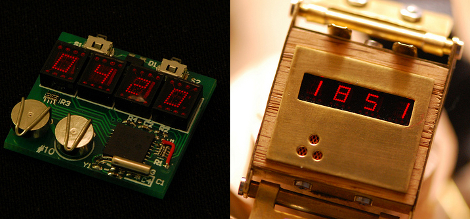
This wristwatch circuit board has some pretty interesting digits. They’re older components that give a classic look to your wristwatch display. On board you’ll find a PIC 16F628A running with an external clock crystal. The display isn’t always illuminated (kind of like Woz’s watch) in order to save the batteries, but can be woken up for a short time with the push of a button. The steam-punk-ish body seen to the left is the just first try. This guy has four more boards left so it should be fun to see what he comes up with.
[Via Hackaday Flickr Pool]















I love how most posts on here that have anything to do with time, it displays 4:20. For that I give this place kudos.
As for the watch… wait, what was I thinking about¿ lol
but really, cool watch.
Just messed around with some SLG2016 dot-matrix LED displays, they are pretty good-looking and easy to use. The price is a bit high though.
These are not the only pretty old displays out there. Digikey loves to sell them for some $50 a piece, which is assault and robbery with subsequent rape. They, and similar displays, pop up on ebay sometimes, sometimes rather expensive too, sometimes for like $1 a piece.
Nice, i have used these kind of display’s last week but what are “throwback digits” ? Never heard of it.
always gotta set the clock to 4:20 for the photoshoot ;)
I actually remember when LED wristwatches like this (just a little smaller) were the only kind of digital watches available, and they were over USD$100 in the 1970’s, and you had to push a button to wake up the display.
Jameco has an “LED Display Grab Bag” that usually includes displays like this (several LED dies forming each segment of a 7seg) and even some legitimate LED wristwatch innards from the 70/80s, though usually the watch units are dead, I’m sure the displays are still good!
the case is pictured to the right… not the left.
a couple years ago I bought a couple replica watches with these displays on ebay. Might be worth searching for the watches and gutting them if they’re cheap.
What’s a good source for buying the LED modules?
The FND-10’s used in this watch are extremely hard to find and almost never appear for sale on Ebay, they would be best avoided if you are looking to build your own watch. By far the most ready source for a display is from another LED watch; broken LED watches can be bought cheaply on Ebay and elsewhere. Be careful when going this route, as some of the cheaper LED watches do not have separate displays, the bare LED dies are attached directly to the main PCB and covered in epoxy. Another good option would be some member of the HDSP-2010 family… these are nice four digit glass-and-ceramic displays in a tiny 12 pin DIP package. They are fully alphanumeric and have built in shift registers, which saves a lot of uC pins. HDSP-2010’s and a myriad similar part numbers from the same family can be found on Ebay fairly regularly for $10 – $15 dollars each.
I want one!
Before I read the article, I thought these displays were the TI hexidecimal units with the integrated BCD decoders, but this is much more awesome…
Anyone have any guesses as to how he has integrated the momentary switches? My quick guess is that either button resets the microcontroller, and then the microcontroller is programmed to poll two of the outputs he is using for the display as inputs at startup, assuming that the microcontroller can reset, and then boot into full operation all during the duration of a human button push, but that would require some sort of one-shot circuit, and he seems to imply that he is only using diodes…
Oh, and I’m also don’t understand why the 13th I/O pin is unusable because it is open-drain. It seems to me that it’s open-drain actually makes the pin MORE usable/versatile. Add the proper glue components(pull-up resistor?) to make it behave as a standard input?
The case is on the right not the left, maybe you need to draw a little L and R on your hands buddy…
My father used to have watches like this in the 1970’s– the first digital watch… or one of the first. It was called a Quasar. He had a men’s version and a women’s version for my mother.
They powered themselves through the kinetic energy of the body, so they never needed batteries. To see the time, you would move your wrist violently for a moment and the display would come on.
I was fascinated by these watches.
I found an ad for them from 1976– lucky to find it, I don’t see anything else on the net with a quick search that even remembers them. :(
http://www.ledwatches.net/advertisements/quasar-ad-l.htm
420 ftw, mad props and love the work!
It’s a bit odd and disappointing that 30+ years after the first LED watches we still don’t have the battery capacity to light them all the time.
The old ones had the bulb-shaped lenses on each LED digit though.
I really want a watch that vibrates when the alarm goes off so I can have a silent alarm also it’ll be more effective at waking me up… maybe
420!!!!!! (12% of the united states gets that :3 )
Who else just goes “meh” and switches off when they read or hear “steampunk”?
Add an accelerometer and turn the display on when the force vector is straight down.